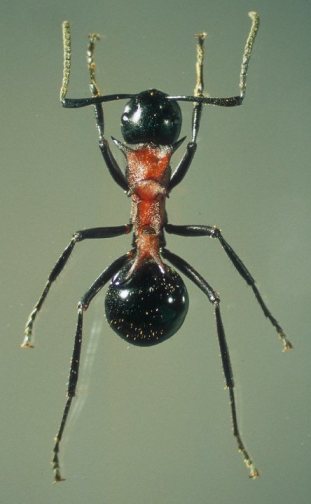Interactions between organisms:
Does it exhibit relationships with other
species?
 The Polyrhachis lamellidens is considered
to be a social parasite of ants from the genus Camponotus. They
are considered social parasites, because in certain instances the queen will
take over the nests of the Camponotus and make the remaining worker
ants their “slaves.” This happens after the queen is inseminated
during its nuptial flight, and instead of starting her own colony she
invades the n
The Polyrhachis lamellidens is considered
to be a social parasite of ants from the genus Camponotus. They
are considered social parasites, because in certain instances the queen will
take over the nests of the Camponotus and make the remaining worker
ants their “slaves.” This happens after the queen is inseminated
during its nuptial flight, and instead of starting her own colony she
invades the n
Incredible entomopathogenic fungus from the genus Cordyceps are a known parasite of many ant species including the Polyrhachis lamellidens. This fungus causes very unique symptoms including mind control! Once an ant becomes infected with the fungus, the Cordyceps fungus will manipulate the ants thinking in order to improve its own chances of reproducing. When the fungus is ready to reproduce it will grow into the ant’s brain. The fungus then produces chemicals that cause the ant to climb to the top of a plant and clamp its mandibles firmly to the plant surface. The fungus then consumes the ant’s brain, and the fruiting bodies of the fungus sprout from the ant’s head and begin producing spores. Once the fungus enters the ant it usually takes around 4-10 days to complete this cycle.
The Polyrhachis lamellidens does not have too many
predators because of its nest location and their large spines. There are
however several organisms that do commonly consume the Polyrhachis
lamellidens which include: Japanese wasps, various spiders, Tinea
carnariella, and Eucharitidae.
-
click
here to
view more enemies of ants.
Does it provide food for other organisms?
The Polyrhachis lamellidens does not directly
provide food for other organisms (except when other organisms eat it) but it
does help pollinate flowers, which provide food for other animals.
Where does it fit in the food web?
This organism is both a primary consumer and a secondary consumer, because it eats both autotrophs and heterotrophs. It is also considered a scavenger, because it will feed on the remnants of dead animal corpses. Since this organism is an insect it doesn’t rank too high in the food web, but as I have mentioned before it does have those protective spines, which are a valuable tool in warding off predators.
Human uses and medicinal purposes:
 The Polyrhachis lamellidens has been used as folk
medicine in China and Taiwan for thousands of years.
Recent tests and clinical trials have shown that the ant possesses 39 known
chemical components that are effective in treating arthritis, rheumatism,
liver ailments, asthma, and cancer. Health food
containing extracts from the Polyrhachis lamellidens have also been
reported to be beneficial in increasing energy, increasing sexual desire,
and prolonging life.
The Polyrhachis lamellidens has been used as folk
medicine in China and Taiwan for thousands of years.
Recent tests and clinical trials have shown that the ant possesses 39 known
chemical components that are effective in treating arthritis, rheumatism,
liver ailments, asthma, and cancer. Health food
containing extracts from the Polyrhachis lamellidens have also been
reported to be beneficial in increasing energy, increasing sexual desire,
and prolonging life.
Research conducted on ethanol extracts of the
Polyrhachis lamellidens showed that the extracts presented great
analgesic and anti-inflamatory capabilites. The extracts
contained two aliphatic polyketide lactones called Polyrhacitide A and B,
and they are very unique in that they have a bicyclic lactone structure.
To put this in lamens terms, the Polyrhachis lamellidens
extracts showed that it has unique chemical properties that make it a
valuable organism for humans to derive medicine from.
What purpose do these chemicals serve in nature?
The gaster of the ant is where the “chemical warfare” is
stored. This is where we find the chemical components in
which we are able to derive medicine from. The ants use
these chemical components as a way to catch prey and help defend against
predators via their stinger.
Other Organisms that live in the same habitat:
Aphids are a very important organism that lives on nearby
plants. The Polyrhachis lamellidens, Camponotus
japnicus, and Camponotus obscuripes all feed on the
sugary honeydew left behind by the aphids. These aphids
can be found on plants such as: Phyllanthus niruri,
sugar cane,
Trillium
grandiflorum, and
Pistacia
vera
Click here to check out some fun facts!
Click here to return to the main page.